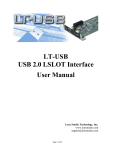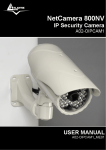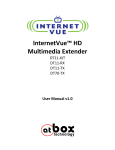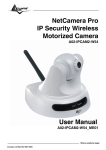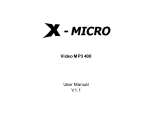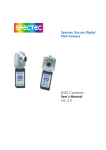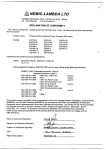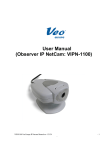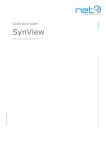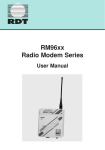Download Atlantis Land 500 Digital Camera User Manual
Transcript
Before you use this Product This Atlantis Land product has been designed with safety in mind. However, if not used properly electrical products can cause fires which may lead to serious body injury. To avoid such accidents, be sure to heed the following. Legal Caution Video and audio surveillance can be forbidden by laws that vary from country to country. Check the laws in your local region before using this product for surveillance purposes. Heed the safety precautions Be sure to follow the general safety precautions and the “Operation Notice.” In case of a breakdown In case of system breakdown, discontinue use and contact your authorized Atlantis Land dealer. In case of abnormal operation • If the unit emits smoke or an unusual smell, • If water or other foreign objects enter the cabinet, or • If you drop the unit or damage the cabinet: 1 Disconnect the cable and the connecting cables. 2 Contact your authorized Atlantis Land dealer or the store where you purchased the product. Operation Notice - Operating or storage location Avoid operating or storing the camera in the following locations: • Extremely hot or cold places (Operating temperature: 0 °C to +50 °C [32 °F to 122°F]) • Exposed to direct sunlight for a long time, or close to heating equipment (e.g., near heaters) • Close to sources of strong magnetism • Close to sources of powerful electromagnetic radiation, such as radios or TV transmitters • Locations subject to strong vibration or shock Ventilation To prevent heat buildup, do not block air circulation around the device. Transportation When transporting the camera, repack it as originally packed at the factory or in materials of equal quality. Cleaning • Use a soft, dry cloth to clean the external surfaces of the device. Stubborn stains can be removed using a soft cloth dampened with a small quantity of detergent solution, then wipe dry. • Do not use volatile solvents such as alcohol, benzene or thinners as they may damage the surface. 2 Index Installation ........................................................... 1 Using IP Camera via Mobile Phone ................... 2 Using IP Camera via Web Browser ................... 3 1. Initial accessing the IP camera ......................................................................................... 5 2. Configuration of Main Menu ............................................................................................. 6 2.1 Setting ...................................................................................................................... 6 2.2 Client Setting ........................................................................................................... 7 2.3 Image Setup ............................................................................................................. 7 2.4 Live View .................................................................................................................. 7 Setting .................................................................................................................................... 9 3. Basic ................................................................................................................................... 9 3.1 System ...................................................................................................................... 9 3.2 Camera ................................................................................................................... 13 3.3 Network .................................................................................................................. 20 3.4 Security .................................................................................................................. 27 4. Advance ............................................................................................................................ 29 4.1 FTP Client ............................................................................................................... 29 4.2 SMTP....................................................................................................................... 35 4.3 HTTP Event ............................................................................................................ 40 4.4 Schedule................................................................................................................. 42 4.5 Motion Detection.................................................................................................... 43 4.6 System Log ............................................................................................................ 45 Installation Installation Steps Follow these steps to install the NetCamera on your Ethernet: 1. Check the package contents against the list below. 2. Set the device. See IP Installer User Manual on the available methods. Package Contents Item IP Camera Power Adapter CD Camera Stand Printed Document Description Atlantis Land IP Camera External 5V 1A User Manual / Software Supplied with mounting screw Quick Installation Guide Overview Front: Body Built-In Mic Camera Stand Rear: Camera Stand Thread Power In Reset Network Audio Out 1 Using IP Camera via Mobile Phone To use IP cameras via mobile phones, please make sure your RTSP is set to “ON”. (Default is “ON”) To change the settings of IP cameras, please see “Settings” for details. 3G Mobile Phone viewing For 3G mobile phone viewing, type “rtsp://<IP>:<PORT>/video.3gp” into your 3G web browser. <IP> is the IP address of your IP camera, <PORT> is the RTSP port of your IP camera (Default value is 8554.) Example: rtsp://100.10.10.1:8554/video.3gp Note: • You can also use RTSP clients (RealPlayer, MPlayer, Windows Media Player, Quicktime…etc.) to view RTSP streaming, just type in “rtsp://<IP>:<PORT>/video.3gp” as the Player’s URL 2.5G Mobile Phone viewing For 2.5G mobile phone viewing, type “<IP>/mobile.wml” into your 2.5G web browser. <IP> is the IP address of your IP camera. 2 Using IP Camera via Web Browser System Requirement To use the product normally, we strongly recommend your computer follows our minimum system requirement (Computer level lower than this might cause some problems) Item Requirements CPU Pentium 4 1600MHz (or equivalent AMD) Graphic Card 64MB RAM graphic cards (or equivalent on-board graphic cards) RAM 512MB Operating System Windows 98, ME (Please see Note) Windows 2000, 2003, XP, Vista Web Browser Internet Explorer 6 or later Note: • If you’re using Windows 98 or ME, please install IP Installer before using WEB UI to ensure the system runs normally. 3 How to Use This chapter introduces how to monitor the image from the device using Microsoft web browser. The Atlantis Land IP camera can be used with Microsoft web browsers and Intelligent IP Installer in Windows operation systems. This document focuses on introducing you to Microsoft web browser. The recommended browser for Windows is Internet Explorer 6.0. If you want to know how to use Atlantis Land IP camera with Intelligent IP Installer, check Intelligent IP Installer User’s Manual in Windows operation systems. The functions of the device should be set by the Administrator. For further instructions on setting the device, see “Setting the Camera” . 4 1. Initial accessing the IP camera 1. Start your web browser, and enter the IP address or host name of the ATLANTIS LAND IP camera in the Location / Address field of your browser. Note: • If you only want to view the video without setting page, enter “http://<IP>/index2.htm” as your web URL. 2. Use the default account “admin” and default password “admin”. Note: • The default user name “admin” and the password are set at the factory for the administrator. You can change them in the Account Menu under Setting on page 19. 3. The monitor image will be displayed in your browser. 5 2. Configuration of Main Menu Language You can click the pulldown box to select system language, including English, Traditional Chinese, Simplified Chinese, German, Japanese and Spanish. 2.1 Setting This function is only for the Administrator. Click this button to get into the Basic and Advance settings menu. 6 2.2 Client Setting Mode: Click the pulldown box to choose between MPEG4 and MJPEG video compression mode. Note:MJPEG streaming is unavailable if RTSP mode is ON. View Size: Select the desired display image resolution to 640X480 or 320X240. Protocol: Select the transferring protocol from TCP, UDP, HTTP and Multicast. Video Buffer: Turn the Video Buffer function On/Off. The Video Buffer function makes the streaming more smoothly in unsteady network environment, but might cause a little delay in live viewing. 2.3 Image Setup You can use the tool bar to optimize video brightness, contrast, and saturation. 2.4 Live View Snapshot: You can capture a still image shot by the camera and save it in your computer. 1. Press , and a snapshot window will appear. 2. Click “Save” to save the picture in your computer. 3. Click “Close” to return to the view page. Zoom in / out the image via the monitor window 7 1. Clickk to display d the digital zoo om in windo ow. 2. Pull the to adjust the digital zzoom rang ge, and it will w be sh howed on the above window. 3. You can c use the e left click of your mo ouse to mo ove the to any w where on th he window.. Audio buttons: b :S Speakers turned on. :M Microphone e turned on n. : Volume control bar. :Speakers tu urned off. :M Microphone e turned offf. Note: • It meanss the speakkers of you ur compute er are turne ed on to tra ansmit the sounds fro om d IP camerra(s). Similarly, means m you u can broad dcast to the connecte ed the connected c via the Eth hernet usin ng your mic crophone. IP camera(s) Video o play butttons: :Pause the e current vid deo :Play the video. v c vide eo. :Stop the current he current vvideo. :Record th 8 Setting 3. Basic Click the “Basic” folder to display the sub folders, including System, Camera, Network, and Security. 3.1 System 3.1.1 Information The Information page provides you with product factory information, including Product name, Firmware version, and Web version. 9 3.1.2 Day & Time Current date & time:This displays the current date and time of the device. PC clock:This displays the date and time of the monitoring PC clock. Date & time format:Click the pulldown box to select among different time display formats, including yyyy-mm-dd hh:mm:ss (year-month-day hour:minute:second), mm-dd-yyyy hh:mm:ss (month-day-year hour:minute:second), and dd-mm-yyyy hh:mm:ss (day-month-year hour:minute:second). Adjust:Select one of four time adjusting modes. Keep current setting:Select this mode to keep the current date and time of the device. Synchronize with PC:Select this mode to make the date and time of the device the same as the monitoring PC. Manual setting:Select this mode to manually adjust the date & time of the device. Synchronize with NTP : Specify the NTP server name and the Refresh Interval to synchronize the date and time of the device with those of the time server, known as the NTP (Network Time Protocol) server. Note: • The NTP server (Network Time Protocol) is the time server which is an Internet standard protocol (built on top of TCP/IP) that assures accurate synchronization to the 10 millisecond of computer clock times in a network of computers. NTP server name:Type the host name or IP address of the NTP server, up to 64 characters. Time zone:Select the time zone and time difference from Greenwich Mean Time in the area where the device is installed from the pulldown box. 3.1.3 Initialize Reboot:Click this button to reboot the device. A confirmation dialogue will appear. Click OK to proceed. It takes about two minutes to reboot the device. Factory default:Click this button to reset the device to the factory default settings. A confirmation dialogue will appear. Click OK to proceed, the network indicator on the device will start to blink. After completing adjustments to the default settings, the device will reboot automatically. Do not turn off the device until the device reboots. Backup setting data:Save the setting data of the device to a file. Click Save, and follow the instructions on the browser to save the setting data file to your specified location. Restore setting:Load the saved setting data of the device. Click Browse and select the file in which the setting data is stored. Click OK, and the device is adjusted according to the loaded data and restarted. Firmware update:Upgrade the device software. Click Browse and select the file for upgrading. A confirmation dialogue will appear. Click OK to start upgrading. The device will reboot upon completion. 11 Note: • Use only upgrade files that are special for this device. Problems may occur otherwise. • Do not turn off the device power or disconnect the network until the upgrading is completed. 12 3.2 Camera 3.2.1 General RTSP: Switch the RTSP streaming On/Off. Note: • RTSP: Real Time Streaming Protocol. RTSP is supported by most of the media clients . (RealPlayer, Media Player, QuickTime, etc…) Image Rotate:Enables user to mirror or flip the display screen. Night Mode:Turn Night Mode ON/OFF. Lighting:Choose the lighting environment among 50Hz, 60Hz and Outdoor. White Balance : Choose the white balance to Auto, Fluorescent, Incandescent and Black&White. Overlay:Select to add Text Overlay or Privacy Mask on/off the display screen. Text Overlay:Enables users to see some information on the display screen, including Date/Time and user-defined text. You can also change the background color. Privacy Mask:Enables users to conceal an area of the video image. 13 3.2.2 MPEG4 3.2.2.1 Computer View RTSP (If RTSP mode is ON) RTSP port: Specify the transmission port number of RTSP streaming video. Default value is 554. Viewer authentication: If the viewer authentication is ON, users viewing through RTSP will be requested to key-in username and password. RTP (If RTSP mode is ON) Unicast streaming: Unicast streaming Video/Audio port range: Specify the transmission port range of RTP streaming video. RTP will select a port randomly from the range. Multicast streaming: Multicast address: Specify the multicast server address. Video / Audio Port: Specify the transmission port number of the video data. Specify an even number from 1024 to 65534. Time-To-Live: Set the maximum TTL that multicast can pass through. 14 MPEG4 viewer port (If RTSP mode is OFF) Unicast streaming Video/Audio port number : Specify the transmission port number of the video data. It is initially set to 8090. Specify an even number from 1024 to 65534. Image Size:Specify the image size the network camera transmits. You can choose among 704 × 480, 352 × 240 and 176 × 120 for NTSC mode and 704 × 576, 352 × 288 and 176 × 144 for PAL mode. Frame rate:Set the frame rate of the MPEG4 image. Selectable values are 5, 10, 15, 20, 25, 30 fps. The unit “fps” stands for “frames sent per second”. Quality Auto:The quality and bitrate will be automatically decided according to the frame rate. Fixed Quality:The selectable values are Medium, Standard, Good, Detailed and Excellent. Fixed Bitrate:Set the bit rate of MPEG4 image transmission for a line. Selectable values are 64, 128, 256, 384, 512, 768, 1024, 1280, 1536 and 2048 kbps. Note: • The selected frame rate and bit rate are a tentative value. The actual frame rate and bit rate may be different according to the image size, the shooting scene or the network condition. 15 3.2.2.2 Mobile View RTSP (If RTSP mode is ON) RTSP port: Specify the transmission port number of RTSP streaming video. Default value is 8554. RTP (If RTSP mode is ON) Unicast streaming: Unicast streaming Video/Audio port range: Specify the transmission port range of RTP streaming video. RTP will select a port randomly from the range. Multicast streaming: Multicast address: Specify the multicast server address. Video / Audio Port: Specify the transmission port number of the video data. It is initially set to 10000 and 11000. Specify an even number from 1024 to 65534. Time-To-Live: Set the maximum TTL that multicast can pass through. Image Size: The Image size of Mobile view is fixed at 176x120. Frame rate:Set the frame rate of the MPEG4 image. Selectable values are 5, 10, 15, 20 fps. The unit “fps” stands for “frames sent per second”. 16 Quality Fixed Bitrate:Set the bit rate of MPEG4 image transmission for a line. Selectable values are 64, 32, and 16kbps.. 17 3.2.3 MJPEG Note: • MJPEG settings are unavailable if the RTSP mode is ON, which means the MJPEG streaming is closed. MJPEG viewer port Unicast streaming Video/Audio port number : Specify the transmission port number of the video data. It is initially set to 8070. Specify an even number from 1024 to 65534. Note: • Unicast streaming:Specify the transmission port number of the video data and audio data used when UDP (Unicast) is selected with the TCP/UDP transmission switching icon in the main viewer. Image Size:Specify the image size the network camera transmits. You can choose among 704 × 480, 352 × 240 and 176 × 120 for NTSC mode and 704 × 576, 352 × 288 and 176 × 144 for PAL mode. Frame rate:Set the frame rate of the MJPEG image. Selectable values are 5, 10, 15 fps. The unit “fps” stands for “frames sent per second”. 18 Quality Auto:The quality will be automatically decided. Fixed quality:The selectable values are Medium, Standard, Good, Detailed and Excellent. 19 3.3 Network 3.3.1 Information MAC address:Display the MAC address of the device. Obtain an IP address automatically (DHCP):If a DHCP server is installed on the network, to select this while the IP address is assigned by the DHCP server. Note: • When you set Obtain an IP address automatically (DHCP), make sure that the DHCP server is working on the network. Use the following IP address:Select this when a fixed IP address is set. IP address:Enter the IP address of the device. Subnet mask:Enter the subnet mask. Default gateway:Enter the default gateway. Use the following DNS server address:Select this when you set the fixed address as the IP address of DNS server. Primary DNS server:Enter the IP address of the primary DNS server. Secondary DNS server:Enter the IP address of the secondary DNS server, if necessary. HTTP port number:Select 80 in general situations. If you want to use a port number other than 80, select the text box and enter a port number between 1024 and 65535. Note: 20 • When you have set the HTTP port number to a number other than 80 on the Network setting page or in the Setup Program, access the device by typing the IP address of the device on the web browser as follows: Example: when HTTP port number is set to 2000 Æ http://192.168.1.100:2000/ 21 3.3.2 PPPoE Use this when you connect the device through PPPoE (Point -to- Point Protocol over Ethernet). PPPoE connection is the protocol that is widely used in xDSL (digital affiliate line such as ADSL, VDSL or SDSL) as the authentication and connection system. IP address:The IP address obtained at the PPPoE connecting with network. User ID:Enter the user ID for authentication necessary for PPPoE connections. Type it up to 64 characters. Password:Enter the password for authentication necessary for PPPoE connections. Type it up to 32 characters. Re-type password:Re-type the password to confirm. Obtain DNS server address automatically:Select this to obtain the address of DNS server automatically. Use the following DNS server address:Select this when you set the fixed address as the IP address of DNS server. Primary DNS server:Enter the IP address of the primary DNS server. Secondary DNS server:Enter the IP address of the secondary DNS server. 22 3.3.3 DDNS Server name:Choose the DDNS Server from the list. User ID:Enter the user ID for authentication necessary for DDNS connections. Type it up to 64 characters. Password:Enter the password for authentication necessary for DDNS connections. Type it up to 32 characters. Re-type password:Re-type the password to confirm. Host name:Enter the host name that is registered to the DDNS server. Note: • When you want to use DDNS function, you need to register an account in DDNS server first. 23 3.3.4 UPnP The device includes support for UPnP, which is enabled by default. If also enabled on your computer, the device will automatically be detected and a new icon will be added to “My Network Places.” It provides port forwarding for opening a port in a router or firewall in a private network in order to let a party from the outside world contact a user inside. HTTP port:Enter the HTTP port number and default HTTP port is 80. SSL port: Enter the SSL port number and default SSL port is 443. MPEG4 viewer port:Enter the MPEG4 viewer port number and default MPEG4 viewer port is 8090. MPEG4 viewer port(SSL): Enter the MPEG4 SSL viewer port and default is 8091. MJPEG viewer port:Enter the MJPEG viewer port number and default MJPEG viewer port is 8070. MJPEG viewer port(SSL): Enter the MPEG4 SSL viewer port and default is 8071. MPEG4 RTSP port: Enter the MPEG4 RTSP port, default value is 8050 for computer view, 8030 for mobile view. 24 3.3.5 IP Notification When network notify type is set to On, you can send an e-mail notification of the completion of the network setting. Notify type:Select type of DHCP, Static IP and PPPoE will notify. SMTP server name:Type the SMTP server name up to 64 characters, or the IP address of the SMTP server. Authentication:Select the authentication required when you send an email. Off: Select if no authentication is necessary when an email is sent. On: When authentication is necessary an e-mail is sent, select one of the authentication methods from the followings. SMTP: Select if SMTP authentication is necessary when an e-mail is sent. POP before SMTP: Select if POP before SMTP authentication is necessary when an e-mail is sent. Note: • When you set to On, be sure to select either or both SMTP or/and POP before SMTP. POP server name:It is necessary when the POP before SMTP is selected in Authentication. Type the POP (receiving mail) server name up to 64 characters, or type the IP address of the POP server. This setting is necessary when the SMTP server which sends e-mails performs authentication using the POP user account. 25 User name, Password:Type the user name and Password of the user who has the mail account. This setting is necessary when the SMTP server which sends e-mails performs authentication. Recipient e-mail address:Type the recipient e-Mail address up to 64 characters. You can specify up to three recipient E-mail addresses. Administrator e-mail address:Type the Administrator e-Mail address up to 64 characters. This address is used for reply mail and sending system messages from the SMTP server. Subject:Type the subject/title of the e-Mail up to 64 characters. With respect to mail which is sent according to the IP notification. Message Type the text of the E-mail up to 384 characters. Default value provides network information including IP, Port, MAC, Model, Firmware Version and Web Version. 26 3.4 Security 3.4.1 Account The device default account and password setting is “admin/admin”. That means everyone might access the device including the configuration as long as the IP address is known. It is necessary to assign a password if the device is intended to be accessed by others. Use this menu to set the user names and passwords of Administrator and up to 9 different users (User 1 to User 9), and the access right of each user. User name:Set a user name between 5 and 16 characters. Password:Set a password between 5 and 16 characters. Re-type password:Re-type the password to confirm. Viewer Mode:Set a user to Admin, Operator or Viewer mode. Viewer authentication:Allows any viewer direct access to Live View. 27 3.4.2 HTTPS HTTPS is a URI scheme used to indicate a secure HTTP connection. It is syntactically identical to the http:// scheme normally used for accessing resources using HTTP. Using an https: URL indicates that HTTP is to be used, but with a different default TCP port (443) and an additional encryption/authentication layer between the HTTP and TCP. You can use the IP camera through HTTPS easily by using https:// instead of http://. Create & Install: Create a self-signed certificate for HTTPS to recognize. Installed Certificate: Display or remove the properties of the installed certificate. HTTPS Connection Policy: Set HTTPS connection policy for different level of users. 28 4. Advance 4.1 FTP Client Use this menu to set up for capturing and sending images to an FTP server. By using FTP client function, you can send the image and audio file which has been shot and recorded linked with the external sensor input or with the built-in motion detection function to FTP server. FTP client setting menu is composed of two tabs, General, Alarm sending and Periodical sending. 4.1.1 General FTP client function:To activate the FTP client function, select On. The FTP client setting page appears. When you do not wish to use the FTP client function, select Off. Note: • The frame rate and operability on the main viewer may decrease while a file is being transmitted by the FTP client function. FTP server name:Type the FTP server name to upload still images up to 64 characters, or the IP address of the FTP server. User name:Type the user name for the FTP server. Password:Type the password for the FTP server. 29 Retype password:To confirm the password, type the same characters as you typed in the Password box. Passive mode:Set whether you use the passive mode of FTP server or not when connecting to FTP server. Select On to connect to FTP server using the passive mode. Attached file type:Set attached file type to MJPEG or MPEG.4 30 4.1.2 Alarm sending Set to forward the image and audio file to the specified FTP server linked with the alarm detection by the external sensor input or by the built-in motion detection function. Select On to send the image and audio file to FTP server linked with the alarm detection. Remote path:Type the path to the destination in FTP server up to 64 characters. Image file name:Type the file name you want to assign to the images when sending to the FTP server. You can use up to 10 alphanumeric characters, - (hyphen) and _ (underscore) for naming. Suffix:Select a suffix to add to the file name: Date & time: The date & time suffix is added to the Image file name. The date/time suffix consists of lower two-digits of year (2 digits), month (2 digits), date (2 digits), hour (2 digits), minute (2 digits), second (2 digits), and consecutive number (2 digits), thus 14-digit number is added to the file name. Sequence number: A consecutive number of 10 digits between 0000000001 and 4294967295 and two fixed digits 00 is added to the Image file name. Motion Detection:Click it on for using Motion Detection function as a sensor. You can set the motion detection function page. Note: • Motion Detection works only when the Video mode is set to MPEG4 and the Cropping is set to Off. 31 Effective period:Set the period when the periodical sending is effective. Always:The periodical sending is always effective. Schedule:You can specify the period when the periodical sending is effective in the schedule setting in the other section. Click Schedule and the setting menu for the effective period is displayed. 32 4.1.3 Periodical sending You can set to send an image file to FTP server periodically by selecting On to send the image file to FTP server linked with setting period. Remote path:Type the remote path up to 64 characters. Image file name:Type the file name of the image sent to FTP server up to 10 alphanumeric characters, - (hyphen) and _ (under score). Suffix:Select a suffix to be added to the file name sent to FTP server. None:The name of the sent file will be the Image file name. Date & time:The date & time suffix is added to the Image file name. The date & time suffix consists of lower two-digits of year (2 digits), month (2 digits), date (2 digits), hour (2 digits), minute (2 digits) and second (2 digits), and consecutive number (2 digits), thus 14-digit number is added to the file name. Sequence number:A consecutive number is added to the Image file name. Sequence number clear:Click Clear and the suffix of the sequence number returns to 1. Interval:Set the periodical sending is effective interval. Min value is 1 min and Max value is 24 hour. Effective period:Set the period when the periodical sending is effective. Always:The periodical sending is always effective. 33 Schedule:You can specify the period when the periodical sending is effective in the schedule setting in the other section. Click Schedule and the setting menu for the effective period is displayed. (“Setting the Schedule — Schedule setting Menu” on page 34) 34 4.2 SMTP Set the SMTP menu when you want to send an image via e-mail. By using Mail (SMTP) function, you can send a mail with attached image which has been shot linked with the external sensor input or with the built-in motion detection function. The image file can also be sent periodically. E-Mail (SMTP) setting menu is composed of three tabs, General, Alarm sending and Periodical sending. 4.2.1 General Select On when you use the SMTP function. The common setting options are displayed below. If you do not wish to use the e-Mail (SMTP) function, select Off and click OK. Note: • During transmission of an image file via mail, the frame rate and operation performance of the monitor image of the main viewer decline. • While the camera video mode is set to MPEG4, the image of the composite video signal output from the video output connector of the camera may be distorted during mail transmission. • You cannot send an audio file by using the mail sending function. SMTP server name:Type the SMTP server name up to 64 characters, or the IP address of the SMTP server. Authentication:Select the authentication required when you send an email. 35 Off: Select if no authentication is necessary when an email is sent. On: When authentication is necessary an e-mail is sent, select one of the authentication methods from the followings. SMTP: Select if SMTP authentication is necessary when an e-mail is sent. POP before SMTP: Select if POP before SMTP authentication is necessary when an e-mail is sent. Note: • When you set to On, be sure to select either or both SMTP or/and POP before SMTP. POP server name : It is necessary when the POP before SMTP is selected in Authentication. Type the POP (receiving mail) server name up to 64 characters, or type the IP address of the POP server. This setting is necessary when the SMTP server which sends e-mails performs authentication using the POP user account. User name, Password:Type the user name and Password of the user who has the mail account. This setting is necessary when the SMTP server which sends e-mails performs authentication. Recipient e-mail address:Type the recipient e-Mail address up to 64 characters. You can specify up to three recipient E-mail addresses. Administrator e-mail address : Type the Administrator e-Mail address up to 64 characters. This address is used for reply mail and sending system messages from the SMTP server. Attached File Type: Select to attach the file as JPEG or MPEG4. Subject:Type the subject/title of the e-Mail up to 64 characters. With respect to mail which is sent according to the alarm detection when Alarm sending of the alarm tab is set to On, the characters standing for the sensor type added to the subject. Message:Type the text of the E-mail up to 384 characters. (A line break is equivalent to 2 characters.) 36 4.2.2 Alarm sending Set to send the mail with connection to the alarm detection by the external sensor input or by the built-in motion detection function. Alarm sending:Select On to set to send mail with connection to the alarm detection. File attachment:Set whether an image file is attached to the mail sent or not. When On is selected, the image file made by the settings below is attached. When Off is selected, only the message is sent. Image file name:Type the file name you want to assign to the image to attach a mail. You can use up to 10 alphanumeric, - (hyphen) and _ (underscore) for naming. Suffix:Select a suffix to add to the file name: None: No suffix is added. The Image file name is assigned to the image to be sent via an e-Mail. Date & time: The date & time suffix is added to the Image file name. The date/time suffix consists of lower two-digits of year (2 digits), month (2 digits), date (2 digits), hour (2 digits), minute (2 digits), second (2 digits), and consecutive number (2 digits), thus 14-digit number is added to the file name. Sequence number: A consecutive number of 10 digits between 0000000001 and 4294967295 and two fixed digits 00 is added to the Image file name. Motion Detection:Click it on for using Motion Detection function as a sensor. You can set 37 the motion detection function page. Note: • Motion Detection works only when the Video mode is set to MPEG4 and the Cropping is set to Off. 38 4.2.3 Periodical sending You can set to send an image file by SMTP server periodically by selecting On to send the image file by SMTP server linked with setting period. Image file name:Type the file name of the image sent by SMTP up to 10 alphanumeric characters, - (hyphen) and _ (under score). Suffix:Select a suffix to be added to the file name sent by SMTP. None:The name of the sent file will be the Image file name. Date & time:The date & time suffix is added to the Image file name. The date & time suffix consists of lower two-digits of year (2 digits), month (2 digits), date (2 digits), hour (2 digits), minute (2 digits) and second (2 digits), and consecutive number (2 digits), thus 14-digit number is added to the file name. Sequence number:A consecutive number is added to the Image file name. Sequence number clear:Click Clear and the suffix of the sequence number returns to 1. Interval:Set the periodical sending is effective interval. Min value is 30 min and Max value is 24 hour. Effective period:Set the period when the periodical sending is effective. Always:The periodical sending is always effective. Schedule:You can specify the period when the periodical sending is effective in the schedule setting in the other section. Click Schedule and the setting menu for the effective period is displayed. (“Setting the Schedule — Schedule setting Menu” on page 34) 39 4.3 HTTP Event Use this menu to set up for capturing and sending images to an HTTP server. By using HTTP client function, you can send the image and audio file which has been shot and recorded linked with the external sensor input or with the built-in motion detection function to HTTP server. HTTP client setting menu is composed of two tabs, General and Alarm sending. 4.3.1 General HTTP event: Set up the HTTP server URL, port, user id, password, and proxy server settings. 40 4.3.2 Alarm sending Set to send the mail with connection to the alarm detection by the external sensor input or by the built-in motion detection function. Alarm sending:Select On to set to send mail with connection to the alarm detection. Motion Detection:Click it on for using Motion Detection function as a sensor. You can set the motion detection function page. Note: • Motion Detection works only when the Video mode is set to MPEG4 and the Cropping is set to Off. Alarm Buffer:Select Use alarm buffer when you forward the image/ audio of before and after the alarm detection (pre-alarm, post-alarm). If you do not select it, only the image of the moment of the alarm detection is forwarded. Click Alarm buffer to display the Alarm buffer setting menu. For details, see “Setting the Alarm Buffer — Alarm buffer setting Menu on page. Effective period:Set the period when the periodical sending is effective. Always:The periodical sending is always effective. Schedule:You can specify the period when the periodical sending is effective in the schedule setting in the other section. Click Schedule and the setting menu for the effective period is displayed. 41 4.4 Schedule When you click Schedule on the Advanced mode menu, the Schedule setting menu appears. This is the same menu as the setting menu which is displayed when you click Schedule to set Effective period and Schedule in FTP client setting menu, e-Mail (SMTP) setting menu, Alarm out setting menu and so on. Example: When setting e-Mail (SMTP) (the alarm sending) in the Schedule setting menu. 4.4.1 Setting Schedule selection Select the list box to specify the schedule you want to set. e-Mail (SMTP) – Alarm, e-Mail (SMTP) – Periodical, FTP – Alarm, FTP – Periodical, HTTP event – Alarm, Alarm output – Alarm or Alarm output – Timer, can be selected. Mon (Monday) to Sun (Sunday) The time period on the right of the checked day is the effective period of the schedule. Start time, End time Specify the Start time and the End time. Use the same time schedule every day When this is checked, the Start time and End time set to Mon (Monday) are applied to all days. In this case, the Start time and End time of the other days than Mon (Monday) cannot be input. 42 4.5 Motion Detection When you click Motion Detection on the Advance mode menu, the Motion Detection setting menu appears. There are three Motion Detection functions as sensors to set for different detecting zones. Each one has Threshold and Sensitivity inputs which you can adjust to specific zone sequentially. Motion Detection function can support to FTP, SMTP and Alarm output for capturing and sending images or starting alarm output. Click it On when you use the Motion Detection function and detecting zone appears for adjusting and moving. The common setting options are displayed below. If you do not wish to use the Motion Detection function, click it Off and press OK. Motion Detection 1:Click it on for using Motion Detection 1 function as a sensor. You can adjust and move the detecting zone by using mouse. Motion Detection 2:Click it on for using Motion Detection 2 function as a sensor. You can adjust and move the detecting zone by using mouse. Motion Detection 3:Click it on for using Motion Detection 3 function as a sensor. You can adjust and move the detecting zone by using mouse. Threshold:You can use the tool bar to set up-limit value. When detecting zone signals are 43 over setting value, it would carry on assigned work. Sensitivity:You can use the tool bar to set down-limit value. When detecting zone signals are over setting value, it would carry on assigned work. Carry out the following steps: 1. Click On to Motion Detection 1 choose one of eight orders. 2. A detecting zone 1 appears and use mouse to adjust and move the zone boundaries and position. 3. Use tool bar to set Threshold and Sensitivity value. 4. Follow the steps to set the other Motion Detection. 5. Click the OK to save the setting. Note: • Be careful! Motion Detection function don’t work with Patrol function at same time. 44 4.6 System Log The System Log function allows users to review any changes and events happened. The system starts logging automatically after started. Remote Log: Enables user to send the log data to a specified log server. 45 Atlantis Land Via Pellizza da Volpedo, 59 20092 Cinisello Balsamo – MI – Italy [email protected] 46

















































